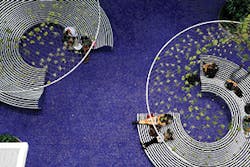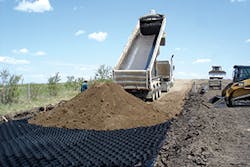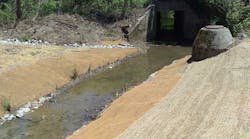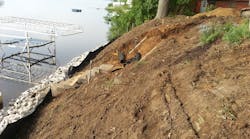It was a series of storms in north Florida in 1957 that led Robert J. Barrett, along with engineers from the University of Florida, to develop the first genuine geosynthetic material. It was used to protect the beaches from erosion. Barrett, president of Carthage Mills who would later become known as the “father of filter fabrics,” would be proud to see how far his development has come. Geosynthetics now do much more than hold back sand. They help build bridges, provide roads in areas previously unmanageable, and help with stormwater management. They’re providing students in Florida a serene study area that was once just cold concrete, and they provide an area for roots to thrive on a roof in Nashville.
Blue Skies—and Floors—in Florida
When Mark B. Rosenberg, president of Florida International University (FIU), sought a transformation of the overlooked Deuxieme Maison (DM) courtyard, he didn’t have far to look. Associate professor and landscape architect chair Roberto Rovira met the challenge with a team of design students enrolled at FIU. Students Jose Alvarez, Luis Jimenez, Martina Gonzalez, and Mario Menendez worked alongside Rovira to design the new space that was later dubbed the “Sky Lounge.”
“The university is always really interested in branding its colors, and the blue glass seemed like a strong yet subtle way of celebrating that wish without using a logo per se,” Rovira explains. “The glass is actually crushed SKYY vodka bottles, though we didn’t know this at first and it wasn’t why I christened it the Sky Lounge.” The name came about because nets within the space frame the sky above, and the vine growing on the adjacent walls is known as skyvine (Thunbergia grandiflora). “The name and the source were a funny coincidence,” he says.
The project began in 2010 with a construction cost of $232,000. The team drew on the knowledge from students in landscape, interior design, and architectural design. Rovira has stated that the Sky Lounge demonstrates the power of design, “particularly the power of landscape architecture, which is about strong visions and bold ideas.”
Referred to as Brutalism, the architectural style that previously dominated the DM building was popular from the 1950s through the 1970s. The style of the late 20th century is characterized by heavy “fortress-like” concrete structures and is often labeled as “cold.” Many North American universities and governmental institutions used the Brutalistic style, as it was said to convey strength and functionality. But cold concrete alone is—well, cold. Many of these buildings are now being renovated, and stucco, rock facing, other elements are used to help lighten and brighten the environments.
The FIU student team lightened the lounge with stainless steel structures and nets that hang high from the ceiling. Covering the nets are more than 3,000 air plants and vines that will continue to thrive and fill in the space. These elevated structures work to complement the Grecian blue ground floor in the courtyard. And although the plants are called “air” plants, the vines have a misting irrigation system to provide the small of water necessary.
The flooring at the lounge is what made the design come together. Made from Invisible Structures’ Gravelpave2 and filled with crushed SKYY vodka bottles, the floor provides beauty and a permeable surface for the water to move through.
“The Gravelpave2 made the use of the porous crushed glass solution viable as an ADA [Americans with Disabilities Act]-accessible surface,” says Rovira. “Since I had seen it used at the September 11 memorial at the Pentagon, it felt like the right durable solution that would concurrently ensure accessibility. One of the other attractive aspects of the Gravelpave2 system is that the PVC circles, which are normally hidden but which we intentionally exposed by making them flush with the top of the crushed glass, worked quite well with the circular design features of the space. The custom-designed benches and planters and the braided stainless steel nets that hold over 3,000 air plants above all work very well together.”
Material from a local crushing operation was used as infill for this “floating road.”
Jim Piersol, principal architect of record with Miami-based MC Harry and Associates Inc., explains that the crushed glass was first rolled and polished, then brushed into the geogrid cells. “It was a unique design used with a basic product. It just happened that there was a side benefit. The air plants have a misting system, so the water had to go somewhere. It just so happened that with this product, we solved that problem as well.”
Miami Dade construction company Stobs Brothers performed the installation and construction. Project manager Barry Stevenson explains more about the blue glass.
“The recycled blue glass was purchased from TriVitro Corporation. It is delivered to the site in 50-pound plastic bags. We installed 280 bags of glass. After the Gravelpave2 was fastened in place, the glass was poured onto the surface and broomed across the surface until all of the rings were filled level with the top.”
TriVitro Corp. settled in Seattle, WA, in 1996 as a manufacturer of 100% recycled glass. Vitrohue tumbled glass is recycled from waste glass made from post-consumer container glass such as beer bottles, liquor bottles, scrap windows, and construction demolition glass. In addition to terrazzo flooring, the glass is used in green roof designs, fountains and water features, mosaic tiles, shower surrounds, and other artistic recycled designs.
A layer of sand underlies the Gravelpave2 and glass. “After the sand was put back in place, they could just roll out the geogrid and backfill with the crushed bottles,” says Piersol.
The total area of the Sky Lounge is approximately 1,800 square feet, with the geogrid and glass area totaling 1,000 square feet. Invisible Structures delivered the Gravelpave2 in rolls 6.56 feet by 65.6 feet. It was rolled out over the sand base and anchored with the fasteners provided with the product. The units are 100% post-consumer recycled HDPE/LDPE and can be filled with gravel or recycled tumbled glass of uniform size. The ability to roll out the flexible geogrid decreases the time, and therefore expenses, of installation.
“Initially, the intent was to install the glass loose, without any type of topping,” says Stevenson. “Due to the amount of traffic across the surface every day, some of the glass was being picked up on peoples’ shoes and tracked outside of the lounge area. We then contacted a terrazzo specialist to remove the glass, using a vacuum cleaner, stockpile it, and then mix it with a clear, non-yellowing epoxy and reinstall it into the rings. This pretty much eliminated the tracking of glass outside the area and still maintained the drainable properties.
“Where the material spanned across the concrete seating bases, it was fastened with Tapcons [screws],” he continues. “The material spanned from end to end and side to side of the recessed area. The top of the rings finished flush with the surrounding concrete walkways. The joint between the perimeter concrete walkways and the Gravelpave2 was covered with a 6-inch-wide aluminum expansion joint cover bedded in mastic and fastened to the concrete with sleeve anchors.”
Rovira says there were a few challenges with the floor. “We initially tried to secure the glass with an epoxy resin, but over time, the resin did not hold, so we periodically top out and spread additional crushed glass to cover any work or uneven areas. The space has become quite popular, and more than 13,000 students traverse the space every semester. Because we added many new electrical outlets and boosted the Wi-Fi signal, students use the courtyard more than they ever had. Consequently, the wear is more than it ever was, so we usually do the filling and grading tune-up before the semester starts and at the end of the semester in time for graduation pictures, since the Sky Lounge has become a very photogenic spot for our graduating students and their families.”
When the project began, the area was a combination of a large concrete slab and open planting areas. Stobs Brothers crews began by saw-cutting and removing the concrete to align with the perimeter columns. “The existing subgrade was mostly compacted lime rock,” says Stevenson. “It was graded and compacted to 95% density 3 inches below the final grade elevation, which is the existing walkway. Two inches of sand screenings were placed over the lime rock, compacted with plate compactors, and screened level.”
There are two aluminum seating pods within the lounge area. The construction crew placed a 4-inch-thick concrete base under each one, matching the diameter of the pod. “Electrical outlets were installed in surface-mounted boxes on the concrete bases. The finished elevation of the bases matches the elevation of the sand screenings. The Gravelpave2 was installed over the sand screenings and concrete seating bases,” says Stevenson.
The maintenance for Gravelpave2 over a 15- to 20-year lifespan is minimal and can provide extra savings over hard paving materials that might need resurfacing. At the Sky Lounge, the maintenance is done primarily by the FIU housekeeping staff.
“Future maintenance is minimal, if any,” says Stevenson. “Any area requiring replacement of glass that may be dislodged can be done easily with additional glass and epoxy. The housekeeping department uses leaf blowers to blow the surface clean of any debris. The glass surface and surrounding concrete walkways are periodically pressure-washed.”
Logistics always seems to be a challenge at construction sites, and there was nothing atypical about the Sky Lounge project. Stevenson says the walkways had a textured surface topping called Spray-Deck. It was necessary for them to be protected during the entire project. Additionally, a challenge was equipment access.
Finished in 2014, gleaming with the Florida International University school colors of blue and gold, the Sky Lounge has become a university icon.
A Green Roof at Music City Center
In Tennessee, the 2013 Governor’s Environmental Stewardship Award in the Building Green Category went to the Music City Center in Nashville. The 1.2 million-square-foot building includes three distinct green roof sections. In addition to the massive roof sections, the building has a 360,000-gallon reservoir, designed to capture rainwater to irrigate outdoor landscaping and to flush the center’s toilets. These features helped move the building toward LEED Silver certification, according to North Carolina-based Bonar Building and Roofing.
In a world where massive construction projects dominate, this cultural icon in Nashville’s SoBro district will compete. The main roof area, with an 180,000-square-foot green roof, presented some challenging characteristics. A rolling surface with pitches ranging from 16–25% provided the greatest challenge for keeping the green roof media stable.
Charlie Miller, president and founder of Roofmeadow, specified Enkadrain W 3601 by Bonar be installed as underlayment and drainage system for the roof’s organic materials. “We want to preserve moisture in the system but prevent soggy or anoxic conditions,” he explains. “It’s thin enough so that it does not impede root growth through it and down to the capillary fabric. Filaments will entangle roots, enhancing the structural integrity of the entire system.”
Baker Roofing Co. of Raleigh, NC, constructed the roofing layers necessary for the success of a green roof. Andy Baker, vice president of technical services for low slope roofing, says, “The waterproofing membrane was the same 60-mil Sarnafil G410 fully adhered membrane as used on the rest of the roof. The difference in the waterproofing roofing system was that the roof insulation was mechanically fastened with a screen wire mesh for leak detection, and the cover board was set in a two-part, low-rise adhesive. For the rest of the roof, the insulation and cover board was fastened to the deck and there is no leak detection. Since the garden roof areas were set on the hills created by the rolling decking, a 1-inch by 1-inch geogrid was used to stabilize the systems. Pavers were used to provide ballast for the perimeter edging, and the aluminum edging for the pavers was tied to the geogrid. Numerous intermediate baffles were also tied to the geogrid to further stabilize the growing media against erosion.”
Following installation of the PVC membrane material, a layer of capillary fabric was laid down. The capillary fabric makes the stormwater runoff flow evenly throughout the green roof media. Although flowing evenly, the stormwater still needs a path to follow to the roof drainage system. With a recycled white polypropylene drainage core and a strong filter fabric thermally bonded on one side, Enkadrain provides this path. It contributes to LEED credits when used on green roofs, as it’s shown to reduce stormwater runoff, the heat island effect, and energy consumption.
The system includes a protection layer and capillary fabric to distribute moisture evenly; a thin drainage layer (Colbond/Bonar 3601); polyester geogrid for stabilization (Stratagrid 200 by Strata Systems Inc.), which helps prevent the system from sliding; lightweight media; and pre-grown sedum mats from Sempergreen with internal organic fiber reinforcement. The plant roots will eventually help stabilize the structure as well.
The design layout by TVS Design resembles the shape of a guitar, honoring the music culture of Nashville. Landscape Support Services LLC and Scott McGaughy with Green Rise Technology installed the green roof system.
“Floating Roads” in Canada
Robert Barrett of Carthage Mills went on in the late 1970s to join forces with the US Army Corps of Engineers in the development of geotechnical fabrics. From their tests in Mobile, AL, fabrics for architectural designs and construction on soft soils were developed, and a whole new frontier was opened for the future uses of filter fabrics.
Although the filter fabrics of Barrett’s days have changed, some of the same strategy is used. In areas of the United Kingdom where roads have to be built across peat-thick lands, or in Canada oil sands where roads are built over very soft, spongy soils, a strategy referred to as “floating roads” is sometimes used. A three-dimensional geocomposite reinforcement is used when a single layer alone won’t prevent weak and soft soils from drifting.
When the gas and oil production construction managers at Devon Canada came to Layfield Group, Alberta, they wanted to find alternatives that would help reduce costs for their lease access roads and drilling pads. The environment is dominated by soft soils and short seasons where the temperatures drop fast.
Their challenges were numerous, but included the need to stabilize the access roads, drilling pads, and platforms over soft soils to reduce the downtime that results from replacing a degraded road or drilling pad.
Devon Canada wanted something that would be easy to deploy, reduce the amount of aggregate needed, allow use of locally available sand, and reduce the amount of operational maintenance required.
Building over saturated clay and other pliable subgrades didn’t end the challenge for Layfield. In this area, suitable fill material for the access roads is either very expensive to purchase and truck in, or it’s limited. To that end, construction managers at Devon requested that Layfield design a road and demonstrate for them how new technologies could offer significant cost savings. Each test section measured 7.6 meters wide by 340 or 240 meters long.
Layfield knew where to look for a product that could handle the challenges. It had a good history with and recommended Presto’s Geoweb load support system.
Bill Handlos, P.E., director of Presto Geosystems, explains why the Geoweb system offers value for areas like this where available fill alone is unsuitable for the job.
“It’s fast to deploy,” he says. “They can use borrowed material that’s not typically acceptable. The Geoweb system also reduces the amount of base necessary, and builders can install the Geoweb geocell throughout the cold of winter. It offers high functional benefit with low environmental impact, and so it’s really an ideal solution for this location.”
The Geoweb three-dimensional cellular structure controls shearing, and lateral and vertical movement of infill materials.
“It also reduces environmental impact to a site by reducing site disturbance, critical in environmentally sensitive areas. Onsite waste fill is often acceptable, conserving local aggregate supplies. Sections are manufactured from HDPE, an inert material that does not contaminate or contribute to groundwater issues, and are shipped to a site in compact form, lowering transportation costs,” adds Handlos.
Layfield proposed a design solution and supplied Presto Geosystems GW30V6 and a LP45G geotextile for Devon. Devon had used the product the previous year at Horn River and was happy with its performance there. For this project, Layfield suggested not using aggregate in the road construction, but instead using rejected screening from local crushing operations as the infill material. The material was coarse sand (<5 mm) and would be used for the Geoweb cross section in place of aggregate.
Construction crews used a small skid steer to spread the coarse sand infill material within the Geoweb cells. After compacting, it was leveled to final grade and put into service.
The owners have been impressed with the performance of the test cross sections. The Layfield design saved on infill material by using reject fines and was able to show a reduction in the amount of fill required to construct a project site.
Using the Geoweb system, Layfield was able to demonstrate that a typical 1.5-meter-deep cross section for a haul road over soft subgrades can be reduced to less than 300 millimeters. This satisfied the cost-savings goal for the owners, who are now using the design and materials for future lease and pad construction.







